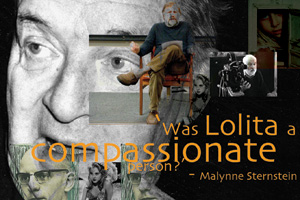Malynne Sternstein, Associate Professor in Slavic Languages & Literature and the College
By Josh Schonwaldjschonwa@uchicago.edu
News Office
 Photo Illustration by Laurie Davis |
|
Malynne Sternstein will lie to her students, she’ll overwhelm them with reading, she’ll assign texts that some, including her own teaching assistants, believe are simply too hard for undergraduates. She’ll also employ, what she calls, “radical friendliness ... I’m almost too friendly for it to be authentic; it too must be questioned.”
For Sternstein, Associate Professor in Slavic Languages and Literature, these are all tactics in her broad effort to cultivate an atmosphere of learning.
“I really want the classroom to be a safe place, a safe place to have conflict.”
And creating that place, Sternstein says, so often begins by creating “the upset.”
A scholar of Czech literature, who has authored a book on the Czech historical avant-gardes, Czechs of Chicagoland, and articles on such topics as iconic language, gender and citizenship in the arts, Sternstein’s scholarly work explores the intersection between art and literature, film and politics.
She teaches classes on Vladimir Nabokov, the modern central European novel, kitsch and the Czech artist Jan Svankmaher. She also teaches the popular class, “Critical Methodology Theory: From Adorno to Zizek,” a foundational class in the Interdisciplinary Studies in the Humanities that she chaired for several years.
In the “Critical Methodology Theory” class, she often will choose the most difficult, most obscure texts.
Sternstein will choose an obscure text by the Lacanian psychoanalyst, Slavoj Zizek, rather than one of his more popular, perhaps accessible works. “If you teach a well-known text, some students will already have a cocktail-conversation answer ready. They come into the class with preconceptions about the text. It’s very hard to dislodge.” Sternstein wants texts that students may not know, so they have to read and react.
Of her penchant for lying, she says, “I will ask questions that are fundamentally wrong.” It’s another way to provoke her students. In a recent discussion about Lolita, she asked, “Was Lolita a compassionate individual?” That’s the wrong question, Sternstein said. “Lolita is just a character in a book. The book is about language. I just wanted to get them to call me on it.”
At the beginning of her Nabokov class, she informed students, “I am going to lie at times. A student quickly responded. “Are you lying now?” “That was a good sign,” Sternstein said. “I could tell it was going to be a good class.”
Sternstein says she has no teaching model inspired by a high school or college teacher, but rather her pedagogical strategy is a reaction to her own frustration with the belief that “there is a right answer.” Sternstein felt that so often that right answer was simply about learning how restate what the instructor was saying.
Her own approach evolved gradually. While teaching “Human Being and Citizen,” Sternstein’s teaching assistant challenged her, openly questioning her decision to assign History of Sexuality, by Michel Foucault, as part of a broader discussion of Genesis. The TA argued that the students, mostly first-years, were too young, that they were inexperienced readers who wouldn’t understand the text. To her surprise, Sternstein found that she wasn’t threatened by the challenge, but rather exhilarated.
Sternstein also found she didn’t mind assigning texts that are considered “too hard.” “If they understand Foucault on sexuality in Eden, that’s fantastic. But even if they misunderstand it, that’s fine.” In teaching a difficult paragraph on, say, Lacan, which most students struggle to understand, she found that working together as a group helped students understand the passage.
Another watershed moment for Sternstein came when she discovered the value of “hot moments.” The most dramatic example of this was early in her career at Chicago when she was teaching a Richard Wright essay in a Humanities core course. The class had proceeded calmly to that point. “It was staid,” she recalled. Two students were dominating a discussion of race. Finally, a student, who had never talked in the class, grew so agitated by the political correctness of the discussion that he entered the fray. He raised his voice. He stood up on his chair, and said, “It’s impossible to move forward when you can still feel the shackles on your ankles.”
This was a dramatic, tense moment. But following that, the student became an engaged interlocutor, and the whole atmosphere of the classroom changed. There was, she recognized, a great benefit to the “hot moment.”
For Sternstein, teaching also is exciting because it’s a chance to make new discoveries. “I’ve read Lolita more than 10 times,” she said. “But every time we read it in class, someone finds a trifle. They’ll notice something in a certain way. This can be an ecstatic moment for me.”
![[Chronicle]](/images/sidebar_header_oct06.gif)